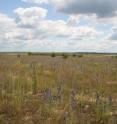Fledgling ecosystem at Chicken Creek lets scientists observe how soil, flora and fauna develop
How do ecosystems develop? No one really knows, yet. There is however one project, unique in the world, seeking to answer this question. In a former open-pit coal mining area in Brandenburg, Germany, a surface of six hectares was partitioned off and then left to its own resources. Scientists from the Technische Universitaet Muenchen (TUM), in collaboration with researchers from other institutions, are studying the development of soil, flora, and fauna there. With this research they aim to establish the factors that have a particularly strong influence on developing ecosystems. Young ecosystems are rare. They can be found, for instance, when ice from thawing glaciers releases the pristine debris it transports -- as is currently the case with the Damma Glacier in the Swiss Alps. In general, though, we are surrounded by age-old ecosystems that have developed over millions of years and whose interactions and structures are well established. Such systems are, for instance, rain forests, deserts, or seas. Scientists do not know much yet about how these systems develop. The geochemical and biological processes that occur during development are for the most part well understood. It is not yet clear, though, how and when they occur and what influences them. In order to unveil nature's secrets, scientists from TUM are participating in an international interdisciplinary project.
To this end, BTU Cottbus constructed a special research area, unique in the world. It is located in a former open-pit coal mining region south of Cottbus and bears the name of a creek that used to flow through there: Huehnerwasser, or Chicken Creek. Regional sediment originating from the ice age was re-deposited, graded, and fenced off over an area larger than six football fields. A protective layer of clay was laid out at a depth of several meters to capture percolating rainwater and direct it toward an artificial spring flowing into a pond. No fertilizer was used, not a single seed planted, no organism artificially cultivated there. Since its completion in the fall of 2005, the world's largest artificial water catchment area has been developing autonomously. It is being meticulously observed, though. As if in an open air laboratory, the BTU Cottbus, the ETH Zurich, and other non-academic partners have been conducting research together with the Technische Universitaet Muenchen on this project since 2007.
TUM researchers are looking into this area from various perspectives. Plant ecologists checked the initial state of the seed reservoir in the soil and are now observing the development of the vegetation, i.e. which plant species settle in the soil, in what order, and where their seeds come from. Forest growth researchers are studying the surface structures. For instance, they regularly measure the changes in soil surface and vegetation. Their goal is to generate a mathematical model that can simulate the dynamic interaction between vegetation and surface development. Soil ecologists look into the soil. They analyze time and again the number and species of microorganisms living in the soil to establish how, over the years, complex microbial communities develop in the soil at Chicken Creek, and why their composition and activity change as the seasons pass.
Professor Ingrid Koegel-Knabner and her team from the TUM Chair for Soil Science are investigating soil development from a different perspective. Their research focuses primarily on humus formation, i.e. the transformation of dead plant material into valuable, nutrient-rich soil. The researchers regularly examine the composition of soil samples in order to study the processes taking place during this initial humus formation stage. Initial results are surprising – soil development and plant colonization at Chicken Creek are progressing more rapidly than originally assumed. "After only five years we see the first trees -- robinias," Koegel-Knabner marvels. "We weren't expecting that in under 20 years. This probably also means that a forest will grow more quickly than expected."
The most important hypothesis of the project is that the starting phase of an ecosystem is decisive. Ingrid Koegel-Knabner: "We don't know yet how long this initial phase takes. But we assume that it influences the entire subsequent development and, therefore, defines the later ecosystem at the outset." Yet what are the prevalent factors that influence the initial phase? It has already become clear that rain is one of these factors. At the very beginning a cloudburst created furrows at the site of the experiment, where water had run off and washed away the soil. The next rain also ran off through these furrows -- they became deeper and wider. That is how the first downpour determined the subsequent course of water flow and thus the locations of the plants.
What other factors play a role in the development could become clear within just a few years. The project is set to run over twelve years altogether. This might sound like a relatively long time; however, in the development time scale of an ecosystem this is practically one instant. Nevertheless, the scientists hope to gain fundamental insights into the initial stages of ecosystem development, which can later be used for targeted intervention into man-made landscapes -- for their re-naturation or re-cultivation.
Source: Technische Universitaet Muenchen
Other sources
- Fledgling ecosystem in former open-pit coal mine in Germany lets scientists observe how soil, flora and fauna developfrom Science DailyThu, 9 Dec 2010, 3:30:42 UTC
- Fledgling ecosystem at Chicken Creek lets scientists observe how soil, flora and fauna developfrom Science BlogMon, 6 Dec 2010, 17:50:23 UTC
- Fledgling ecosystem at Chicken Creek lets scientists observe how soil, flora and fauna developfrom PhysorgMon, 6 Dec 2010, 17:02:08 UTC
